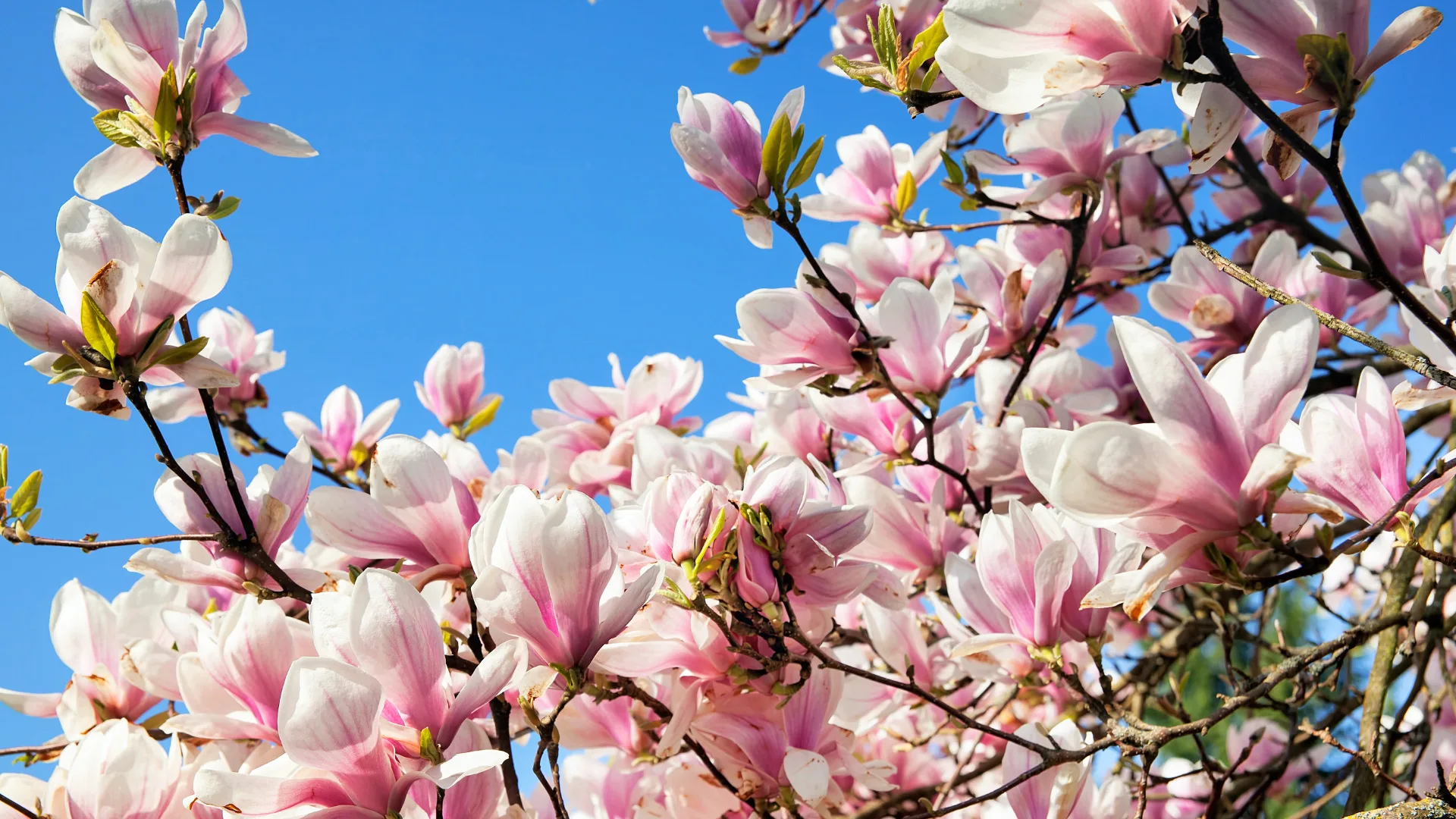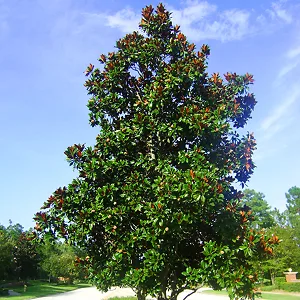
Written by davethetreecenters • May 20 Meet the Magnolias
Say ‘Magnolia’ to a southerner and their mind conjures up images of huge white blossoms like dinner plates, and big evergreen trees with glossy foliage. Say it to a northerner and they see tulip-shaped pink or purple blossoms on bare branches in early spring. What is the connection, and which one should you be growing in your own garden? Let’s meet the Magnolias.
Magnolia trees are ancient – among the very first flowering plants. They are so ancient that when they evolved there were no bees, so they instead used beetles as pollinating insects. Fossil magnolias date back 95 million years or more, and some species that still exist today are at least 20 million years old, according to the fossil record. When you bring a magnolia into your garden you open a window into the history of life itself. Because they are so ancient the continents were not in the same places when they first appeared, and have drifted apart, carrying magnolias with them in two directions, creating one group of them in east Asia, and another group here in North America, central America and the Caribbean. This split is reflected in our opening, because those southern magnolias come from North America, while the type mostly seen in the north are from Asia. Let’s start close to home.
The Southern Magnolia
No magnolias grow naturally in Europe, so when the first explorers and settlers arrived here, it was a new tree to them. The sweetbay magnolia, Magnolia virginiana was the first magnolia officially named, and this native tree from Florida and the south is often grown in gardens. Much more popular in gardens, though, is its relative, the Southern Magnolia, Magnolia grandiflora, which, as its name suggests, has much bigger flowers. This stunning tree, with its large and glossy green leaves and white flowers up to 12 inches across, depending on the variety, is a majestic plant that should be grown wherever it is warm enough. These trees are tough and drought-resistant, and grow in most soils, with few problems, yet those look fabulous all year round.
For gardeners in zone 6 the good news is that varieties like ‘Edith Bogue’ and ‘Kay Parris’ are hardy even in zone 6, while most others need to be in zone 7 to do well. In both those zones a sunny exposure is needed, and growing them flat against a wall, as it often seen in Britain and Europe, is ideal. Simply spread out the young branches as they grow and attach them with loose ties to a wall. The effect is stunning, especially in summer, and the perfume from the flowers drifts though open windows. If you don’t have a lot of room, remember that there are smaller varieties too, such as ‘Little Gem’ and ‘Teddy Bear’, that never grow over 20 feet, and can easily be kept even smaller. For today’s gardens these are often the top choices.
There are many other magnolias, mostly evergreen, found growing in forests and jungle throughout Mexico and Central America, as well as on the islands of the Caribbean. These are rarely seen in gardens, as most need tropical conditions. Other tropical magnolias are found in southern Asia, and one from the Philippines, Magnolia champaca, is the source of the exotic scent champaca, used in luxury perfumes such as ‘Joy’
Deciduous Magnolia
In northern gardens you are much more likely to see a very different kind of magnolia, with soft gray bark and smaller green leaves which drop in fall. Rather than blooming over a long period in summer, these trees burst into full bloom in early spring, before the leaves emerge, and put on a spectacular show. These are either species or hybrids that came originally from China and Japan, and many colors have been developed by breeders over the years, from pure white to rich, deep purples. Of special interest are those with yellow flowers, which at first were disappointing, but now, with the arrival of spectacular trees like the Butterflies Magnolia, have really come into their own. That tree has upright, tulip-shaped flowers with many petals, in bright, citrus-yellow, and it really turns heads.
One problem with these trees is late frost, which can kill the flower buds as they are developing, and if you live in an area like that, look out for magnolias from the Girl Series. These were developed at the National Arboretum, Washington, by hybridizing several species. The result is a great range of trees that flower about two weeks later than most others, so they stay dormant longer, and avoid those killing late frosts. Whether you choose ‘Ann’, ‘Betty’, ‘Jane’, or one of the others in this series, you are sure of a bold display every spring.
Perhaps the most spectacular of the hybrid deciduous magnolias is a variety called ‘Galaxy’. It has enormous blooms on a magnificent specimen tree, and they are brilliant pink, certainly the strongest coloring of any magnolia there is. If you find one, don’t hesitate.
In the coldest zones the best magnolia to grow is the white flowering Star Magnolia, Magnolia stellata, or one of its varieties. This tree is hardy throughout zone 4, and although it blooms early, seems never to miss a year. Varying from large bushes to small trees, you can’t go wrong with this tree, and varieties like ‘Royal Star’ have especially abundant bloom. For more color choose the pale-pink ‘Centennial’, with many petals in its large and beautiful flowers.
For something more exotic . . .
Magnolias have been recently re-organized by botanists, based on DNA studies. A group of related trees called Michelia, have now been re-named as Magnolia. The champaca mentioned earlier is one example, and these trees are favorites with serious magnolia enthusiasts. One of them, living in New Zealand, Mark Jury, spent 20 years breeding these exotic trees, crossing them with many other magnolias, and produced something completely new, the Fairy Magnolias. These are evergreen, but with flowers more like those on deciduous magnolias, many shades of pink. These are remarkable for blooming not just once, in spring – although they do that in profusion – but again over the summer months. These beauties are still only rarely available, but if you can find one you will certainly be at the cutting edge of magnolia heaven.






